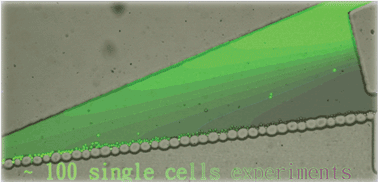Dose-dependent cell-based assays in V-shaped microfluidic channels†
Abstract
The capability of lab-on-a-chip technologies in controlling cell transportation, generating concentration gradients, and monitoring cellular responses offers an opportunity to integrate dose-dependent cell-based bioassays on a chip. In this study, we have developed microfluidic modules featured with channel components and sandbag structures for positioning biological cells within the microchip. We have demonstrated that by geometric modulation of the microchannel architectures, it is possible to immobilize individual cells at desired locations with controllable numbers, to generate defined concentration gradients at various channel lengths, and to improve the efficiency and reproducibility in data acquisition. The microfluidic module was used to exercise a series of cell-based assays, including the measurement of kinetics and dynamics of intracellular enzymatic activities, the analysis of cellular response under the stimulation of two chemicals with defined concentration profiles, and the study of laser irradiation effect on cellular uptake of photosensitizers. The results demonstrated the capabilities of the microfluidic module for simultaneously conducting multiple sets of dose-dependent, cell-based bioassays, and for quantitatively comparing responses of individual cells under various stimulations.


 Please wait while we load your content...
Please wait while we load your content...